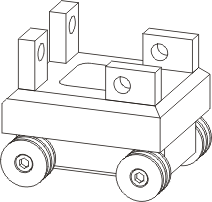Referencing
Referencing parts is undoubtedly the most efficient method for re-using parts, with a distinction needing to be made between external referencing and internal referencing.
Please note:
Referencing is not suitable for parts and assemblies that are based on Design variants, e.g. the Steel Engineering connections, or parts and assemblies that are created by means of configurators, e.g. the Staircase Configurator, Railing Configurator or Bar Configurators.
External referencing
Externally referenced parts are characterised by their ability to be used across projects and across enterprises. The 3-D body that represents this part is not closely integrated into the model, but only added when the model is created in the current state.
External referencing of parts has the following advantages:
- Frequently required company-specific parts can be managed and changed much more effectively from a constructive perspective if they are referenced. The major advantage of this technique is that parts or assemblies can be processed and updated by a team.
- If a drawing contains referenced parts, the system checks automatically to see whether they exist in changed form. Changed parts are automatically updated, if required. Even when a drawing is saved, only the parts that have been changed are saved again. This ensures high speed even for complex drawings.
- Application possibilities for referenced parts include changing and managing company-specific standard parts as well as construction unit systems.
- If the HELiOS database is being used, referenced parts are blocked for other users while they are being processed. Only when the part has been released again are automatic update and other changes possible.
The following description is meant to illustrate the rough procedure for using externally referenced parts based on a simple carriage.
A simple carriage consists of a chassis, four wheels which are fastened to the chassis by means of bolts and four flanges to which the superstructure is fastened.

- Working
without Referencing
If you are working without any referencing, you first construct the carriage. Next, a wheel and a bolt are created and fitted. The other three wheels and bolts can then be created by copying. Subsequent changes to a copy do not affect the other copies; they also need to be changed manually.
- Working
with Referencing
You can avoid this effort by defining wheel and bolt as referenced parts. In this case, you construct the carriage, a wheel and a bolt. Next, you save wheel and bolt as referenced parts. You then use the Insert Part function (Drawing tab or context menu for parts) to fit the remaining wheels as referenced parts. You then save the drawing. If you make subsequent changes to wheels or bolts, you only need to make changes to one wheel or one bolt. These changes can then be automatically transferred to the other parts - even in other drawings.
![]() In addition, wheels or bolts saved as referenced parts
can be used in any other drawings.
In addition, wheels or bolts saved as referenced parts
can be used in any other drawings.
Internal referencing
In addition to external referencing, you can also reference 3-D parts internally, i.e. without saving the part. Internal referencing allows you to manage identical parts within a drawing without saving referenced parts.
Please note:
Please do not insert referenced parts as sub-parts of externally referenced parts, as this may lead to errors!

External Referencing (3-D) • Internal Referencing (3-D) • Referencing Functions (3-D)
